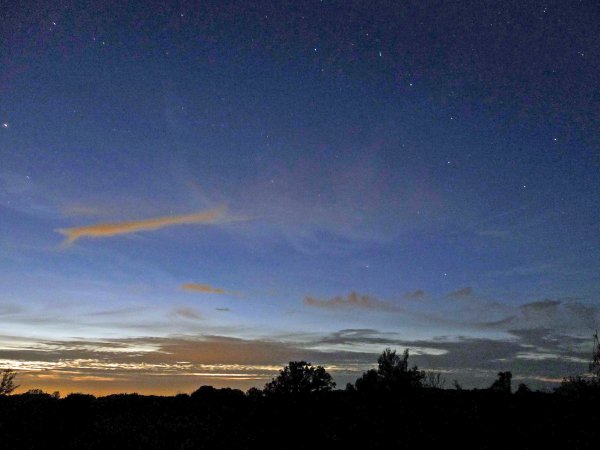Last week on Wordless Wednesday, I found a striking post by David Williams. (Click on his name to see the photo of the starry evening sky.) It immediately captured my full attention. Fortunately, all you have to do is hover the cursor on the image to bring up the technical details. The next question was, “Can I do that?”
I tried, but I was too late to get the effect I wanted. The photo is probably worth sharing.

The dipper handle points to Arcturus.
What do you think? I barely managed to get Arcturus in the shot. It is the brightest star in the northern celestial hemisphere.
A few minutes later I took a shot of the dipper. During the 30-second exposure, a visitor raced across the scene.

A visitor streaks through the lower left portion of the frame.
Can you see the meteor’s trail? It was another “happy surprise.”
I’m not satisfied with these results, so I’m going to try some other ideas. If they work better, you may hear about it.

Wow! Cool capture of all the amazing things happening in the night sky.
Thanks, Lin. :tiphat:
Good job though, for a beginning. I haven’t figured out my camera enough to do something like this. I love the pictures that last all night and show the star trails wheeling around the pole.
Thanks, Shark. Those are neat too, but I don’t have the equipment for that.
I like both pictures. My teen daughter likes to take my first grader outside and show him constellations (she’s pretty good at identifying them too). They used to get a blanket and do it until my boy (yeah, the boy) got chicken of things that might crawl up on the blanket or in the grass around them. My girl has no fear of such things. 😉 Now they stand and do it. 😉
That’s really great. Hat’s off to your daughter. :tiphat: For her knowledge and for being a really super sister.
I’d love to catch a meteor in a picture. I saw one when I first moved to my current home. Now whenever I go out at night I look for one to streak across the sky.
Random meteors can streak across the sky at any time. There are times during the year when you are more apt to see them. Do an Internet search on “meteor shower” to find the time of the next expected “shower.” We’ve always had good luck in August with the Perseids. Even at that, you may have to wait 20 minutes for the next meteoric appearance. Good luck.
FWIW, I’ve taken time exposure (30 – 60 sec) shots of starry skies. A few times I’ve discovered meteors in the pics that I didn’t notice until post-processing. :beam:
Neat!
Thanks, Bill. :tiphat: